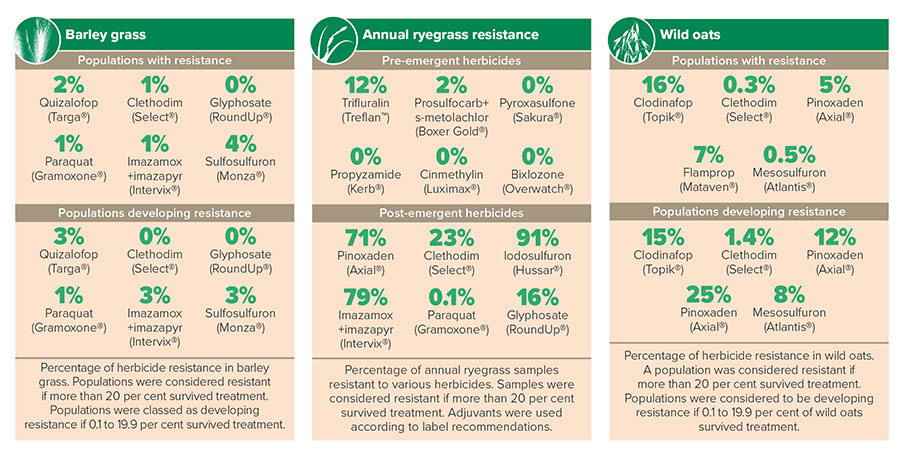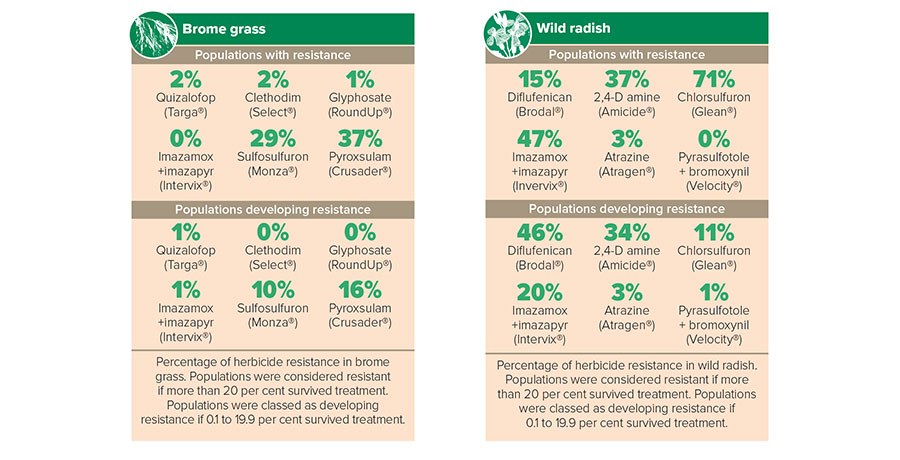Key points
- A national survey shows weed resistance to herbicides is increasing
- The survey tracked herbicide resistance in annual ryegrass, wild oats, brome grass, barley grass, sow thistle, Indian hedge mustard, feathertop Rhodes grass, flaxleaf fleabane, awnless barnyard grass and sweet summer grass
- Annual ryegrass resistance to glyphosate has increased significantly
- Using non-herbicide weed management tactics helps to slow the onset of herbicide resistance
- Sending weed escapes for herbicide resistance testing enables effective products to be selected
The latest Australia-wide survey of weeds has painted a concerning picture about increased herbicide resistance among weeds, particularly annual ryegrass
Australia’s latest multi-agency weeds survey has revealed a significant increase in annual ryegrass resistance to glyphosate.
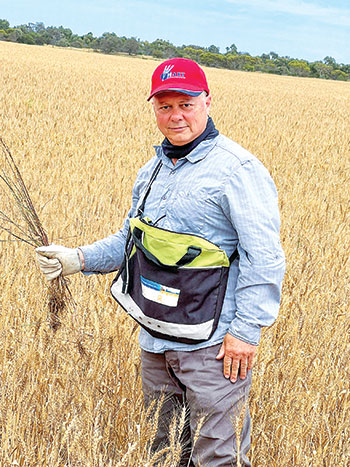 The University of Adelaide’s Dr Peter Boutsalis collects annual ryegrass resistance samples in South Australia. He says annual ryegrass resistance to pre-emergent herbicides remains low. Photo: Lucas Curtarelli
The University of Adelaide’s Dr Peter Boutsalis collects annual ryegrass resistance samples in South Australia. He says annual ryegrass resistance to pre-emergent herbicides remains low. Photo: Lucas Curtarelli
Research leader Dr John Broster from Charles Sturt University says the Australia-wide 2020-21 survey results are significant because 16 per cent of annual ryegrass populations are now confirmed glyphosate-resistant.
“Four years ago, three per cent of annual ryegrass randomly surveyed from growers’ paddocks nationally was confirmed glyphosate-resistant,” he says.
“The 13 per cent jump is a major concern in light of the possible phase-out of paraquat, an effective knockdown herbicide that plays an important role in integrated weed management.”
Dr Broster encourages growers to use non-herbicidal weed management tactics to prolong the life of available effective herbicides.
“We need to think about how we can maximise the use of our herbicides before we lose them.”
The University of Adelaide’s Dr Peter Boutsalis notes annual ryegrass resistance to pre-emergent herbicides remains low (Figure 1), except for trifluralin resistance in South Australia (38 per cent).
Pre-emergent herbicides
“Although 12 per cent of annual ryegrass populations were resistant to trifluralin (Treflan®), only two per cent were resistant to prosulfocarb + s-metolachlor (Boxer Gold®),” he says.
“Pleasingly, there was nil annual ryegrass resistance to pyroxasulfone (Sakura®), propyzamide (Kerb®), cinmethylin (Luximax®) and bixlozone (Overwatch®).”
Figure 1: Herbicide resistance in Australian annual ryegrass,wild oats and brome grass (2020-21).
Source: Charles Sturt University
Post-emergent herbicides
The survey showed high levels of annual ryegrass resistance to post-emergent herbicides.
“Nationally, 71 per cent, 23 per cent, 91 per cent and 79 per cent of annual ryegrass samples were resistant to pinoxaden (Axial®), clethodim (Select®), iodosulfuron-methyl (Hussar®), and imazamox + imazapyr (Intervix®), respectively (Figure 2).”
Dr Boutsalis says a University of Adelaide study in which clethodim was applied to the same populations at the three to four-leaf stage and the two to three-tiller stage showed significantly higher control when clethodim was applied to younger plants.
“Accordingly, growers applying clethodim to older plants might encounter higher failure rates than indicated by the survey results.”
Other ways to improve clethodim efficacy, he says, include:
- spraying at warmer temperatures;
- using high-quality products and adjuvants;
- effective spray application; and
- adding butroxydim (Factor®).
- Wild oats
Dr Broster says 16 per cent of wild oat samples were resistant to clodinafop (Topik®), and a further 15 per cent were developing resistance (Figure 2).
“Seven per cent of wild oat populations were resistant to flamprop (Mataven®) with a further 25 per cent developing resistance.
“Five per cent of wild oats populations were resistant to pinoxaden (Axial®) with a further 12 per cent of populations developing resistance.”
He says only two samples were resistant to clethodim (Select®) and three to mesosulfuron-methyl (Atlantis®). No samples were resistant to tri-allate (Avadex®).
Brome grass
Dr Mechelle Owen, a senior research officer with the Australian Herbicide Resistance Initiative (AHRI), says 37 per cent of brome grass populations screened were resistant to pyroxsulam (Crusader®) and 29 per cent were resistant to sulfosulfuron (Monza®) (Figure 2).
“Herbicide screening results show that 10 per cent more brome grass populations were developing resistance to sulfosulfuron (Monza®) and 16 per cent to pyroxsulam (Crusader®).
“Brome grass populations with resistance to sulfosulfuron (Monza®) were also resistant to pyroxsulam (Crusader®).”
She says resistance to the other herbicides was much lower.
Figure 2: Herbicide resistance in Australian barley grass and wild radish (2020-21).
Source: Charles Sturt University
 Australian Herbicide Resistance Initiative senior research officer Dr Mechelle Owen says high sulfonylurea resistance in brome and barley grass was expected given the limited herbicide control options for these weeds in crop rotations. Photo: Evan Collis
Australian Herbicide Resistance Initiative senior research officer Dr Mechelle Owen says high sulfonylurea resistance in brome and barley grass was expected given the limited herbicide control options for these weeds in crop rotations. Photo: Evan Collis
Barley grass
Dr Owen says results showed that resistance was generally low for all herbicides, with sulfosulfuron (Monza®) having the highest resistance level (Figure 1).
“Sulfosulfuron (Monza®) resistance was identified in WA with 10 populations showing resistance and a further six populations classified as developing resistance.
“No resistance to sulfosulfuron (Monza®) was detected in other states except one NSW population developing resistance.”
She says paraquat resistance was detected in SA, Tasmania, WA and NSW. “There are a few populations with resistance to quizalofop-p (Targa®) from SA and WA,p;with some also having resistance to clethodim (Select®). No resistance was detected to glyphosate.
“Sulfonylurea resistance (SU) in brome and barley grass is expected given the limited herbicide control options for these weeds in crop rotations.”
She says post-emergent herbicides, such as the fops/dims, imidazoline and knockdown herbicides, effectively control most brome and barley grass populations.
“The release of CoAXium® barley will provide additional control options for brome grass where SU resistance is widespread, while Group 1 resistance remains low in this species.”
Wild radish
Dr Owen says screening results for wild radish showed high levels of resistance to 2,4-D amine (Amicide®), chlorsulfuron (Glean®), imazamox + imazapyr (Intervix®) and diflufenican (Brodal®) (Figure 2).
Her results showed atrazine (Atragen®) still controls most wild radish populations.
“Commercial herbicide mixtures provided reasonable control with bromoxynil + pyrasulfotole (Velocity®) remaining effective at controlling almost all wild radish populations screened,” she says.
“Picolinafen + bromoxynil + MCPA (Flight®), MCPA + pyrasulfotole (Precept®) and bromoxynil + diflufenican (Jaguar®) also provide reasonable control (80 per cent) of MCPA + diflufenican (Tigrex®) provided much lower control.”
Sow thistle
Dr Broster says 73 per cent of the sow thistle populations were resistant to chlorsulfuron (Glean®), ranging from 25 per cent in Tasmania to 83 per cent in NSW.
“Only 3.4 per cent of populations tested with 2,4-D amine (Amicide®) were resistant, and these were from NSW and Queensland. The good news is no populations were resistant to glyphosate (RoundUp®).”
Figure 3: Indian hedge mustard herbicide resistance in South Australia and Victoria (2020-21).
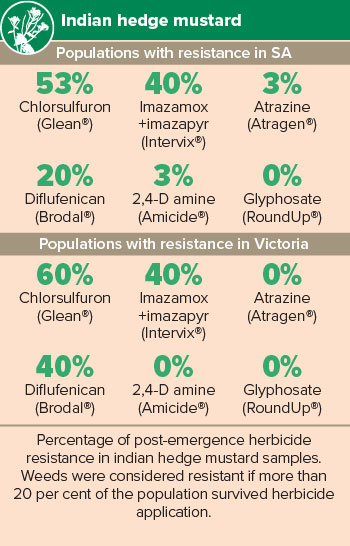
Source: Charles Sturt University
Indian hedge mustard
Of the Indian hedge mustard samples collected, Dr Boutsalis says more than half were resistant to chlorsulfuron (Glean®), with fewer resistant to imazamox + imazapyr (Intervix®) and diflufenican (Brodal®).
“A small number of samples were resistant to atrazine (Atragen®) and 2,4-D amine (Amicide®), but there was no resistance to glyphosate (RoundUp®).
Figure 4: Glyphosate resistance in Queensland summer weeds (2021).
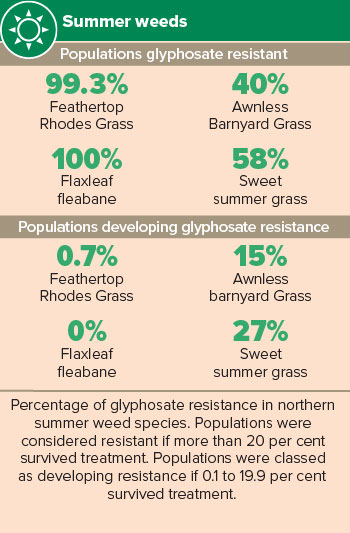
Source: Charles Sturt University
Summer weeds
Queensland Department of Primary Industries’ principal research scientist, Dr Michael Widderick, says 100 per cent of flaxleaf fleabane and 99.3 per cent of feathertop Rhodes grass populations were resistant to glyphosate. (Figure 4).
“Increased glyphosate resistance in summer weeds was expected because of the heavy reliance on the herbicide for fallow weed control,” Dr Widderick says.
“The first-time discovery of all fleabane species resistant to paraquat + diquat (Spray.Seed®) is concerning because these herbicides are commonly used alone or as a second knock partner in double knocks.”
He says there were no summer grass weed populations with resistance to Group 1 herbicides.
“There was no resistance to these herbicides in awnless barnyard grass and to glufosinate in fleabane. This means these herbicides remain effective for control of these weeds.
“Group 1 (FOPs, DIMs and DENs) herbicides are commonly used for fallow control of weeds as part of a double knock. Resistance to Group 1 herbicides needs to remain a priority for detection, especially since resistance to Group 22 (paraquat, diquat) herbicides has now been confirmed.”
In summer weed management, Dr Broster says the size of the weed you target plays a significant factor in control.
“People often delay their summer sprays, thinking it is more economical to apply herbicides to larger weeds once, but spraying smaller weeds in cooler conditions without dust generally leads to better control results.”
Putting it together
Dr Broster says the survey results demonstrate how quickly difficult-to-manage weeds can develop herbicide resistance.
He says herbicide resistance often comes from weed escapes on fencelines.
“Our survey randomly selected weeds from growers’ paddocks, so it is essential to achieve 100 per cent control of weeds on fencelines, using different control tactics where possible.
“What is done in the fenceline area to manage weeds will eventually impact the rest of the paddock through pollen and seed movement.”
Weed escapes
With harvest fresh in the rear-view mirror, Dr Broster says most people will know the location of their weed escapes.
“Weeds such as sow thistle or fleabane can be targeted during fallow over summer and early autumn. If you saw annual ryegrass escapes as you were harvesting, you’ll know where to concentrate your control efforts ahead of sowing.” He says an integrated approach targeted to specific weeds is recommended to delay herbicide resistance.
“A continuous cropper might look at an impact mill, whereas a mixed farmer could use a pasture phase and a chaff line because sheep preferentially graze these areas,” Dr Broster says.
“A chaff line also lets you know where the weeds are, allowing you to direct your subsequent weed management efforts to these areas.”
More information: John Broster, jbroster@csu.edu.au;
Peter Boutsalis, peter.boutsalis@adelaide.edu.au;
Mechelle Owen, mechelle.owen@uwa.edu.au;
Michael Widderick, michael.widderick@daf.qld.gov.au
Resources: WeedSmart, weedsmart.org.au, WeedSmart’s ‘The Big 6’
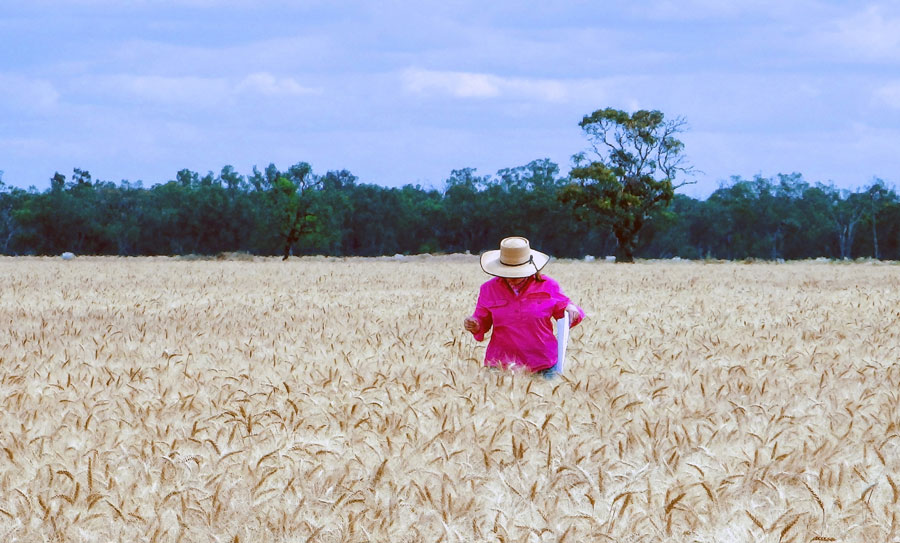
Charles Sturt University Bachelor of Agriculture student Montana Cronin collects weed escapes in wheat for herbicide resistance testing. Photo: Allison Chambers
Australian researchers share the work
Thirty staff worked on the latest Australian herbicide resistance survey of weeds using a standardised approach developed by five research partners. With co-investment from GRDC, the collaborating research agencies included Charles Sturt University, the University of Adelaide, the University of Western Australia, the University of Sydney and the Queensland Department of Primary Industries.
The weed samplers spent 15 minutes walking about 100 metres in an M-shape, starting about 20m into a paddock. More than 2700 samples were gathered.
National effort
Annual ryegrass samples were sent to the University of Adelaide; wild oats and sow thistle to Charles Sturt University; wild radish, brome grass and barley grass to the University of Western Australia; and summer weeds to the Queensland Department of Agriculture and Fisheries.
The 2024-2025 weeds survey started in November. A summer weeds survey is scheduled for March-April. Over the next three years, the team will screen the sampled weed populations for herbicide resistance.
Resistance testing
Charles Sturt University’s Dr John Broster says an effective integrated weed management plan relies on knowing which herbicides do not work and those that do.
“Not all weed escapes are due to herbicide resistance. They may be caused by poor application, a lack of sprayer calibration or stressed weeds.”
To rule out herbicide resistance and know which herbicides to use, send samples to:
Peter Boutsalis, Plant Science Consulting, Adelaide, SA, info@plantscienceconsulting.com.au
John Broster, Charles Sturt University, Wagga Wagga, NSW, jbroster@csu.edu.au
Roberto Busi, University of Western Australia, Perth, WA, roberto.busi@uwa.edu.au


























































